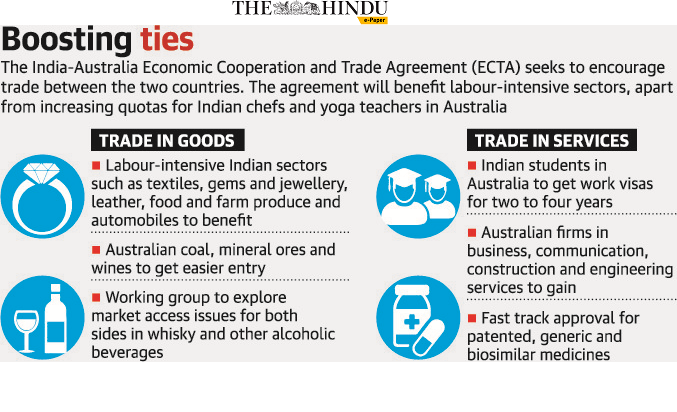Context:
Union Minister of Commerce and Industry, Consumer Affairs, Food and Public Distribution and Textiles said that duties on 100 percent tariff lines would be eliminated by Australia under the landmark India-Australia Economic Cooperation and Trade Agreement (Ind-Aus ECTA).

Relevance:
GS II- International Relations
Dimensions of the Article:
- India-Australia ECTA
- Main features
- Dispute settlement mechanism
India-Australia ECTA
- The Agreement spans cooperation throughout the entire gamut of bilateral economic and commercial relations between the two friendly countries, and it is India’s first trade agreement with a developed country in more than a decade.
- It covers topics such as trade in goods, rules of origin, trade in services, technical barriers to trade (TBT), sanitary and phytosanitary (SPS) measures, dispute resolution, natural person movement, telecommunications, customs procedures, pharmaceutical products, and other areas of cooperation.
- As part of the Agreement, eight subject-specific side letters addressing various sectors of bilateral economic cooperation were also signed.
- The ECTA is expected to increase trade between the two sides to $45-50 billion over five years, from the current estimate of $27 billion, and create over 10 lakh additional job opportunities.
- Under this agreement, India will give 85% of Australia’s exports zero-duty access to its domestic market. India is expected to get zero-duty access to Australia for its goods over five years.
- The negotiations had begun over a decade ago in 2011, but were restarted in September 2021.
Main features:
- The ECTA is guided by a Preamble and is divided into multiple sections that will govern what is hoped to be the most expansive bilateral trade since the two countries established diplomatic ties before India attained independence.
- It has a section on goods exports, and lays out clearly “Rules of Origin” that are aimed at creating anti-dumping measures.
- There are also sections that are aimed at providing remedies and mechanisms for resolving trade disputes. The Commerce Ministry underlined that this is the first trade deal signed by India that has a compulsory review mechanism after 15 years of implementation.
What are the rules of origin included in the agreement?
The rules of origin are based on the principle that they should be “wholly obtained or produced in the territory of one or both of the parties”. This section ensures that waste material will not be exported by either side unless they contribute to the production of any of the items listed in the ECTA.
Will Australia get access to India’s agriculture market?
- With limited exceptions, Australia will be able to export some agricultural items like as potatoes, lentils, and meat products under this agreement.
- Bovine meat, on the other hand, is not included in the agreement.
- Under this agreement, Australia may also provide machines that are required for food processing.
- India may become the first country in the world to allow a wide range of alcoholic and non-alcoholic beverages, including Australian beer.
- In India, wines costing more than $5 may be subject to lower import charges.
Indian side:
- The Indian side said Australia will provide ‘preferential access’ to “all the labour-intensive sectors” of export items from India such as gems and jewellery, textiles, leather, footwear, furniture, food, engineering products, medical devices and automobiles.
- India will also allow Australia to export raw materials under preferential terms like coal and mineral ores.
Services sector:
- The Government of India has said that Australia has “offered wide ranging commitments” in around 135 sub-sectors and Most Favoured Nation in 120 sub-sectors which cover key areas of the Indian services sector like IT, ITES, business services, health, education and audio-visual services.
- Indian chefs and yoga teachers will be given special admission quotas into Australia, while Indian students studying in Australia will be able to obtain work visas on a’reciprocal’ basis for periods ranging from 18 months to four years.
- According to the pact’s provisions, students who complete a diploma in Australia will be considered for an 18-month work visa; those who complete their undergraduation will be considered for two years; and those with a Ph.D. would be considered for a four-year visa.
Pharmaceuticals sector:
- India and Australia have agreed to enable fast track approval for patented, generic and biosimilar medicines.
- Therapeutic Goods Regulators of both sides will have a role to play in monitoring and ensuring smooth trade in pharma products between the two sides.
- Both sides have agreed to audits of imports that require sanitary and phytosanitary inspection as per the law of the land.
- The importing side will ensure that plants and plant products, animal products and other goods, and their packaging are inspected through recognised methodologies.
- If either party finds examples of non-compliance, remedial measures will be taken by both sides.
Dispute settlement mechanism
- Under Article 13.5, both parties have agreed to hold consultations — and make “every effort” to find a solution — in case of disputes that may emerge in the course of trade in goods or services.
- They have also recognised that in case they have to resort to international arbitration, they may opt for an organisation (i.e, World Trade Organization) where both are members.
- They may also use “good offices” and form panels with qualified members drawn from government and business to resolve the disputes.
- The dispute resolution may range from 45 days to 15 months.
-Source: The Hindu



